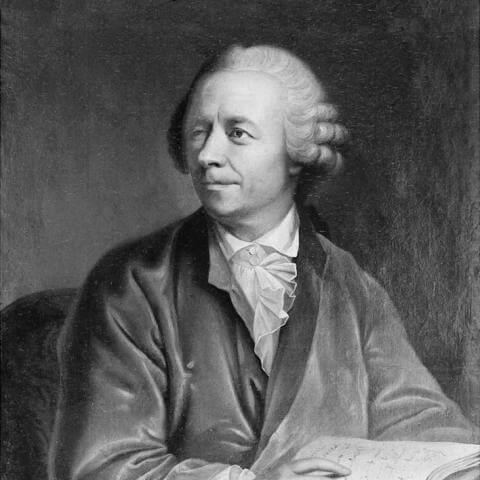The mathematician who lost his eyes for mathematics: Leonhard Euler
Leonhard Euler (born April 15, 1707, Basel, Switzerland - died September 18, 1783, Saint-Peterburg, Russia) was a Swiss mathematician and physicist. He is considered one of the most important mathematicians of the 18th century and one of the leading mathematicians of all time. As one of the most prolific mathematicians, his work in total exceeds 70 volumes.

Euler developed many new concepts and proved many theorems that have long been accepted in different fields, from simple arithmetic to number theory and topology. During these studies, he became the creator of the modern mathematical terminology used today and defined the concept of a function and its spelling. Some of the examples that can be given for this study are the definitions of sin, cos and tan for trigonometric functions.
Euler's father was Paul Euler and his mother was Marguerite Brucker. Euler had an increasing interest in mathematics throughout his childhood and was being tutored by a family friend, Johann Bernoulli. At the University of Basel, Euler studied theology, Hebrew and Greek, although he did not find mathematics as interesting as his father's request. But Bernoulli convinced the father, Paul Euler, that his son had the talent to become a great mathematician. Euler graduated from the University of Basel in 1726. During his education he was interested in the work of many famous mathematicians such as Varignon, Descartes, Newton, Galileo, van Schooten, Hermann, Taylor, Wallis and of course Jacob Bernoulli, and reconstructed some of them.
In 1727, he participated in the award-winning problem competition organized by the Paris Academy. The question that year was to find the best way to place masts on a ship. The honorable mention he won that year was quite commendable for someone who was only 20 years old. Euler to St. He was recommended to teach in the application of mathematics at the Petersburg Academy. Although he accepted the offer in November 1726, he did not go to Russia until the following summer. During this time Euler made an unsuccessful application to the University of Basel. Leaving Basel on April 5, 1727, he went to St. He settled in Petersburg. In 1730 he became a professor of physics. In 1733, when Bernoulli returned to Basel, Euler was promoted to senior scholar in mathematics. On January 7, 1734, he married Katharina Gsell, the daughter of a painter from the Academy Gymnasium. They had thirteen children, eight of whom died in childhood. Euler remarried to his first wife's half-sister. Euler began to have some health problems in 1735. He fell ill with fever, and in 1740 he lost sight of his right eye. Although he recovered temporarily with the surgical intervention, he started to lose his vision again. A new surgical intervention in 1771 caused him to lose his other eye. Due to the ongoing turmoil in Russia, St. He was undecided whether to leave Petersburg or not. Frederick the Great of Prussia Berlin Academy offered Euler a job, and Euler took it positively. On June 19, 1741, Euler returned to St. He left Petersburg. After spending 25 years in Berlin, where he wrote more than 380 articles, he would spend the rest of his life in St. He returned to Petersburg. He died on 18 September 1783 as a result of a cerebral hemorrhage.
Euler worked in almost all areas of mathematics: geometry, arithmetic, trigonometry, algebra, and number theory. In addition, he contributed to space-time continuum mechanics, lunar theory, and many other fields. Euler's knowledge is more general than would be expected from someone who had so enthusiastically pursued mathematics and astronomy. He made important studies in medicine, botany and chemistry. He was also an excellent historian and a great reader. He was known for his extraordinary memory, and was known for his ability to memorize the conclusions he reached through deep thought or reading. He could repeat the entire Aeneid of Virgil (an epic poem in ancient Greek) without error and could specify the first and last lines of each page of the edition he used.
Euler's work, if published in its entirety, would have taken up 60 and 80 quarto volumes. According to estimates, it would take 50 years to copy all of his work by hand, working 8 hours a day. In memory of Euler's 200th birthday, the project started by the Swiss Academy of Sciences in 1907, to bring together and print all his works, is still continuing despite over 100 years. All of his works published to date have been reprinted, making up only a quarter of all his work. It is also planned to print notebooks and personal notes, and it is estimated that this will take about 20 years. According to Legendre, Euler could do a complete mathematical proof between two meals. Euler and Legendre never met, although their views were quite parallel.
Euler has worked in so many fields that it is often possible to come across as a reference on any subject. Mathematicians and physicists joke with colleagues who make a discovery or develop a theorem as "the first person after Euler to discover it." Euler was the founder of fundamental analysis, graph theory, and many of the physical applications of mathematics that are now fundamental to civil, mechanical, electrical, and aerospace engineers.
